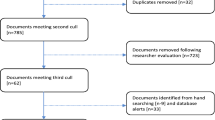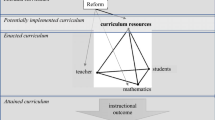Abstract
This paper examines the outcomes of a 4-year implementation of a mathematics program (Representations, oral language and engagement in Mathematics: RoleM) for Australian Aboriginal and Torres Strait Island students’ learning of mathematics across the first 4 years of primary school (Foundation—Year 3). It specifically aims to determine how engagement in teaching and learning mathematics changes as beginning teachers and student participate in the RoleM project. Data were collected from teachers across the 4 years of the RoleM project who were working in schools with young Aboriginal and Torres Strait Islander students. This paper draws on data from 22 beginning teachers (in their first 3 years of teaching) who participated in three semi-structured interviews. Findings indicate that the relationship between the constructs of engagement are potentially on a continuum, with changes in teacher perspectives of their own engagement and students’ engagement acting in a synchronised manner.





Similar content being viewed by others
References
Allard, A., & Santoro, N. (2004). Making sense of difference? Teaching identities in postmodern contexts. In P. Jeffery (Ed.), Doing the public good: Positioning educational research AARE 2004 international education research conference proceedings (pp. 1–20). Victoria,: Australian Association for Research in Education.
Allinder, R. M. (1994). The relationship between efficacy and the instructional practices of special education teachers and consultants. Teacher Education and Special Education,17, 86–95.
Arcavi, A. (2003). The role of visual representations in the learning of mathematics. Educational Studies in Mathematics,52(3), 215–241.
Australian Council of Assessment and Reporting Authority (ACARA). (2013). My school. Retrieved from http://www.myschool.edu.au. Accessed 15 Nov 2018.
Bandura, A. (1992). Self-efficacy mechanism in psychobiologic functioning. In R. Schwarzer (Ed.), Self-efficacy: Thought control of action (pp. 355–394). Washington, DC: Hemisphere.
Bandura, A. (1997). Self-efficacy: The exercise of control. New York: W. H. Freeman and Company.
Bennison, A. (2015). Supporting teachers to embed numeracy across the curriculum: A sociocultural approach. ZDM Mathematics Education,47(4), 561–573.
Bobis, J., Way, J., Anderson, J., & Martin, A. J. (2016). Challenging teacher beliefs about student engagement in mathematics. Journal of Mathematics Teacher Education,19(1), 33–55.
Bodovski, K., & Farkas, G. (2007). Mathematics growth in early elementary school: The roles of beginning knowledge, student engagement, and instruction. The Elementary School Journal,108(2), 115–130.
Borman, G. D., & Kimball, S. M. (2013). Teacher quality and educational equality: Do teachers with higher standards- ratings close student achievement gaps? The Elementary School Journal,106(1), 3–20.
Burns, R. (2000). Introduction to research methods. Sydney: Pearson Education.
Callingham, R., Beswick, K., & Ferme, E. (2015). An initial exploration of teachers’ numeracy in the context of professional capital. ZDM Mathematics Education,47(4), 549–560.
Castle, K., & Aichele, D. B. (1994). Professional development and teacher autonomy. In D. B. Aichele & A. F. Coxford (Eds.), Professional development for teachers of mathematics (pp. 1–8). Reston Virginia: National Council of Teachers of Mathematics.
Cohen, J. W. (1988). Statistical power analysis for the behavioural sciences. Hillsdale, NJ: Lawrence Erlbaum Associates.
Connell, J. P. (1990). Context, self, and action: A motivational analysis of self-system processes across the life-span. In D. Cicchetti (Ed.), The self in transition: Infancy to childhood. Chicago: University of Chicago Press.
Connell, J. P., Halpern-Felsher, B. L., Clifford, E., Crichlow, W., & Usinger, P. (1995). Hanging in there: Behavioral, psychological, and contextual factors affecting whether African American adolescents stay in school. Journal of Adolescent Research,10, 41–63.
Connell, J. P., & Wellborn, J. G. (1991). Competence, autonomy, and relatedness: A motivational analysis of self-system processes. In M. R. Gunnar & L. A. Sroufe (Eds.), Self-processes and development (pp. 43–77). Hillsdale: Lawrence Erlbaum Associates.
Council for the Australian Federation. (2007). The future of schooling in Australia. Retrieved from http://apo.org.au/system/files/3139/apo-nid3139-48716.pdf. Accessed 15 Nov 2018.
Darling-Hammond, L., & Post, L. (2000). Inequality in teaching and schooling: Supporting high-quality teaching and leadership in low-income schools. In R. D. Kahlenberg (Ed.), A notion at risk: Preserving public education as an engine for social mobility (pp. 127–167). New York: Century Foundation.
Eckert, S. A. (2013). What do teaching qualifications mean in urban schools? A mixed-methods study of teacher preparation and qualification. Journal of Teacher Education,64(1), 75–89.
Fredricks, J. A., Blumenfeld, P., & Paris, A. (2004). School engagement: Potential of the concept, state of the evidence. Review of Educational Research,74(1), 59–109.
Friedman, I. A. (2000). Burnout in teachers: Shattered dreams of impeccable professional performance. Psychotherapy in Practice,56, 595–606.
Goldin, G., & Shteingold, N. (2001). Systems of representations and the development of mathematical concepts. In A. A. Cuoco & F. R. Curcio (Eds.), The roles of representation in school mathematics (pp. 1–23). Reston: NCTM.
Guskey, T. R. (1988). Teacher efficacy, self-concept, and attitudes toward the implementation of instructional in- novation. Teaching and Teacher Education,4, 63–69.
Hoy, A. W., & Spero, R. B. (2005). Changes in teacher efficacy during the early years of teaching: A comparison of four measures. Teaching and Teacher Education,21(4), 343–356.
Kedar-Voivodas, G. (1983). The impact of elementary children’s school roles and sex roles on teacher attitudes: An interactional analysis. Review of Educational Research,53, 415–437.
Klassen, R. M., & Chiu, M. M. (2010). Effects on teachers’ self-efficacy and job satisfaction: Teacher gender, years of experience, and job stress. Journal of Educational Psychology,102(3), 741–756.
Labone, E. (2004). Teacher efficacy: Maturing the construct through research in alternative paradigms. Teaching and Teacher Education,20(4), 341–359.
Lawson, M. A., & Lawson, H. A. (2013). New conceptual frameworks for student engagement research, policy, and practice. Review of Educational Research,83, 432–478.
Martin, A. J. (2006). The relationship between teachers’ perceptions of student motivation and engagement and teachers’ enjoyment of and confidence in teaching. Asia-Pacific Journal of Teacher Education,34(1), 73–93.
Merton, R. (1953). Social theory and social structure. London: Free Press of Glendale.
Miller, J., & Warren, E. (2014). Exploring ESL students’ understanding of mathematics in the early years: Factors that make a difference. Mathematics Education Research Journal,26(4), 791.
Ministerial Council for Education Early Childhood Development and Youth Affairs (MCEECDYA). (2011). Aboriginal and Torres Strait Islander education action plan 2010–2014. Retrieved from http://www.educationcouncil.edu.au/site/DefaultSite/filesystem/documents/ATSI%20documents/ATSIEAP_web_version_final.pdf. Accessed 15 Nov 2018.
Mulholland, J., & Wallace, J. (2001). Teacher induction and elementary science teaching: Enhancing self-efficacy. Teaching and Teacher Education,17, 243–261.
Newmann, F. (1981). Reducing student alienation in high schools: Implications of theory. Harvard Educational Review,51, 546–564.
Organisation for Economic Co-operation and Development (OECD). (2014). Pisa 2012 results in focus: What 15-year-olds know and what they can do with what they know. Retrieved from https://www.oecd.org/pisa/keyfindings/pisa-2012-results-overview.pdf. Accessed 4 Feb 2019.
Organisation for Economic Co-operation and Development (OECD). (2018). Equity in education: Breaking down barriers to social mobility. Retrieved from https://read.oecd-ilibrary.org/education/equity-in-education_9789264073234-en#page1. Accessed 4 Feb 2019.
Peterson, P., Swing, S., Stark, K., & Wass, G. (1984). Students’ cognitions and time on task during mathematics instruction. American Educational Research Journal,21, 487–515.
Reschly, A. L., & Christenson, S. L. (2012). Jingle, jangle, and conceptual haziness: Evolution and future directions of the engagement construct. In S. Christenson, A. Reschly, & C. Wylie (Eds.), Handbook of research on student engagement (pp. 3–19). New York: Springer.
Ross, J. A. (1998). The antecedents and consequences of teacher efficacy. In J. Bropy (Ed.), Advances in research on teaching (Vol. 7, pp. 49–73). Greenwich: JAI Press.
Skinner, E., & Belmont, M. J. (1993). Motivation in the classroom: Reciprocal effects of teacher behavior and student engagement across the school year. Journal of Educational Psychology,85, 571–581.
Smith, J., Flower, P., & Larkin, M. (2009). Interpretative phenomenological analysis: Theory, method and research. London: Sage.
Stipek, D. (2002). Good instruction is motivating. In A. Wigfield & J. Eccles (Eds.), Development of achievement motivation (pp. 309–332). San Diego: Academic Press.
Strauss, A., & Corbin, J. (1998). Basics of qualitative research: Procedures and techniques for developing grounded theory. Thousand Oaks: Sage.
Tschannen-Moran, M., & Hoy, A. W. (2001). Teacher efficacy: capturing an elusive construct. Teaching and Teacher Education,17(7), 783–805.
Tschannen-Moran, M., Hoy, A. W., & Hoy, W. K. (1998). Teacher efficacy: Its meaning and measure. Review of educational research,68(2), 202–248.
Warren, E., Harris, K., & Miller, J. (2014). Supporting young ESL students from disadvantaged contexts in their engagement with mathematics: Teachers’ pedagogical challenges. International Journal of Pedagogies and Learning,9(1), 10–25.
Warren, E., & Miller, J. (2013a). Enriching the professional learning of early years teachers in disadvantaged contexts: The impact of quality resources and quality professional learning. Australian Journal of Teacher Education, 38(7), 91–111.
Warren, E., & Miller, J. (2013b). Young Australian Indigenous students' effective engagement in mathematics. Mathematics Education Research Journal, 25(1), 151–171.
Warren, E., & Miller, J. (2015). Supporting english second language learners in disadvantaged contexts: Learning approaches that promote success in mathematics. International Journal of Early Years Education,23(5), 192–208.
Warren, E., & Miller, J. (2016). Mathematics at the margins. Singapore: Springer.
Acknowledgements
The research reported in this paper was supported by the Australian Research Council (LP100100154) and the Department of Education, Employment and Workplace Relations.
Author information
Authors and Affiliations
Corresponding author
Additional information
Publisher's Note
Springer Nature remains neutral with regard to jurisdictional claims in published maps and institutional affiliations.
Rights and permissions
About this article
Cite this article
Miller, J., Warren, E. & Armour, D. Examining changes in young Aboriginal and Torres Strait Island students and their beginning primary school teachers’ engagement in the teaching and learning of mathematics. ZDM Mathematics Education 52, 557–569 (2020). https://doi.org/10.1007/s11858-019-01077-1
Accepted:
Published:
Issue Date:
DOI: https://doi.org/10.1007/s11858-019-01077-1




